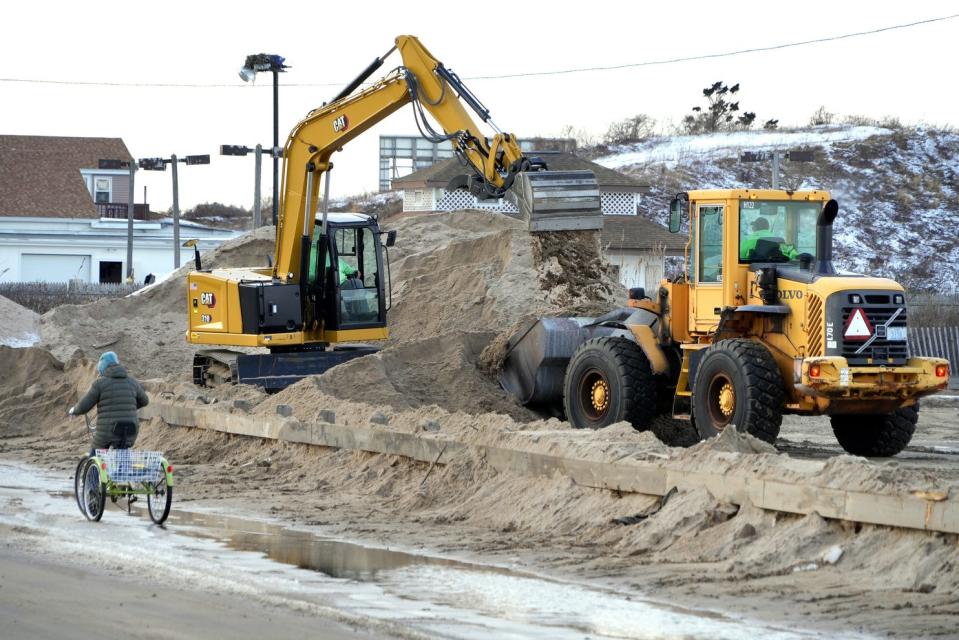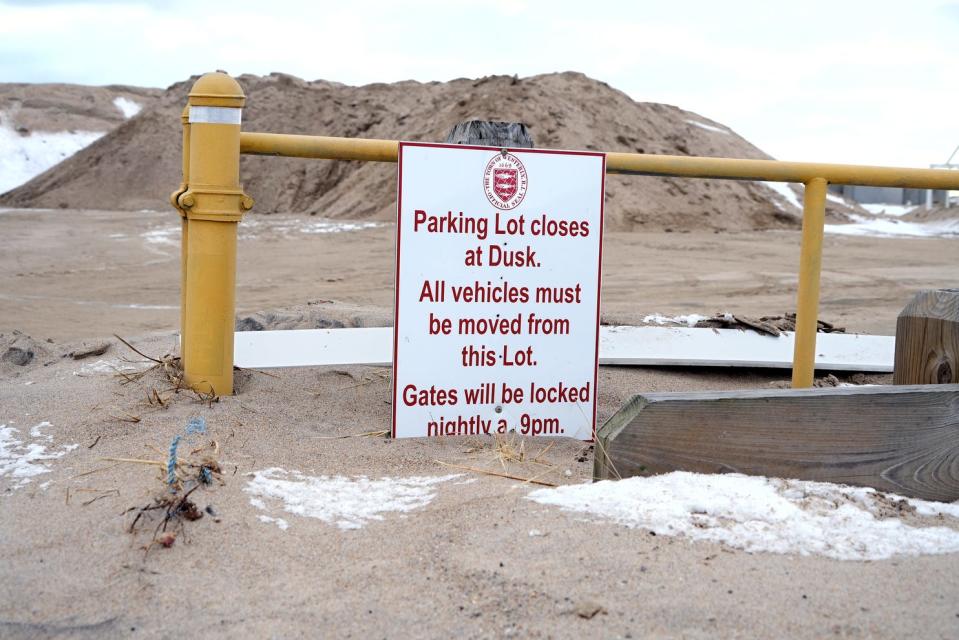Back-to-back storms leave empty spaces where dunes once stood in Westerly
WESTERLY – It’s a case of deja vu for public works employees here.
For the third time in a month, they’re cleaning coastal roads and sidewalks of sand and debris after a big storm.
Crews were still at it Wednesday after Saturday’s storm, just the latest to wash out the dunes along the Misquamicut shoreline. In each instance, the wind-driven storm surge and pounding waves on top of it carried the sand into Atlantic Avenue, which runs parallel to the beach.
Town Manager Shawn Lacey said the mounds of sand rose three and four feet high in the roadway, totaling tens of thousands of cubic yards that had to be removed.
Empty spaces where dunes once stood
Just as in other parts of Rhode Island’s southern coast, it was the succession of powerful storms in a short window of time that led to such extensive erosion in Westerly. Coastal geologists have described the degree of damage along the south shore as the worst since Superstorm Sandy in 2012.

None of the recent storms were as bad as Sandy, but they combined to wreak havoc from Westerly to Narragansett, destroying dunes, washing away beaches and tearing up sections of roadway.
“There’s a cumulative effect of all of them coming, one after the other, before places can recover,” said Bryan Oakley, chair of the Environmental Earth Science Department at Eastern Connecticut State University.
The damage to dune systems was exacerbated because the storm surges didn’t just wash over them and inundate areas on the back sides with water, said Oakley. Instead, waves collided with the dunes and their force carved out sand from the front sides.
The impacts were felt at state beaches all along the coastline, from East Matunuck to Roger Wheeler to Misquamicut, said Mike Healey, a spokesman for the Rhode Island Department of Environmental Management. Sand has been piled up in parking lots and will be restored to dunes and beaches in the spring.
More: Shocking erosion along coastal RI the worst since Superstorm Sandy, experts say
"It was unusual because it wasn't just one place that was hit," Healey said. "It was all of them."
In places along the Misquamicut shore, the dunes look normal from the road, but when viewed from the beach, it’s obvious that huge sections are missing. Lacey described one place where the dunes rose up 18 feet before the storms.
“It’s an 18-foot drop now,” he said.
Property damage was minimal
In Watch Hill and other parts of town, there was flooding, but the waters have since receded. There was a more lasting impact on the Sand Trail, an unpaved track that runs the length of Quononchontaug Beach. Parts of it are now completely gone.
If there’s good news for Westerly, it’s that property damage was minimal. There were busted doors and broken windows, but homes and businesses were more or less unscathed. That may in part be due to rebuilding efforts after Sandy in which structures were raised up to get them above floodwaters.

And although Atlantic Avenue was covered in sand and flooded with ocean water – Lacey said a pumping system for the road was removing 2.8 million gallons of water every eight hours during the latest storm and still struggled to keep up – the roadway itself didn’t suffer any structural damage.
The same wasn’t true in other communities. In South Kingstown, Matunuck Beach Road suffered some damage even though it’s protected by a seawall and a section of Charlestown Beach Road was completely ripped out.
The state Coastal Resources Management Council on Wednesday issued an emergency approval to temporarily repair the latter damage by filling the affected area with gravel, restoring access to five homes on the South Kingstown side of the road.
Clean-up is costly
Cleaning up after the storms is expensive. Lacey hasn’t gone over the numbers yet but says it may be as much as $75,000 in man-hours and equipment costs each time.
He worries about the possibility of another storm, but says the focus now is on the clean-up. Town workers know what to do by now. They clear the roads first, piling sand in parking lots before moving it to the beach, and then get to work on the sidewalks.
“It’s not something you want to be good at, by any means,” Lacey said.
This article originally appeared on The Providence Journal: Dune washout at Misquamicut leaves behind costly cleanup for Westerly
